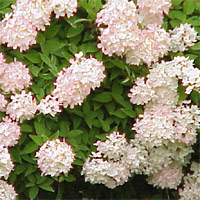Hydrangea

Hydrangeas are deciduous shrubs or vines with large leaves and showy flowers. The flowers are arranged in large clusters for a dramatic show.
About This Plant
Hydrangeas bloom in midsummer to fall, depending on the species. Flower colors include blue, pink, red, and white. The most common type, bigleaf hydrangea (
H. macrophylla), generally grows 3 to 6 feet tall and wide and bears huge, ball-shaped or flat-topped (lacecap) clusters of flowers. Flower color is influenced by soil pH: acidic soils yield plants with blue flowers, while alkaline soils lead to pink flowers. Bigleaf hydrangeas produce flowers on the previous year's growth. In northern areas, the plants may die back to the ground in winter, so although the plants may survive, they will not flower. Climbing hydrangea (
H. anomala) is a clinging vine that grows well on stone walls, arbors, brick walls, and even other trees. It can reach 50 feet tall and becomes heavy and woody with age, so it needs sturdy support.
Special Features
Good for cut flowers
Care
Apply a layer of compost under the tree each spring, spreading it out to the dripline (the area under the outermost branches). Add a 2- to 4-inch layer of mulch to retain moisture and control weeds, keeping mulch a few inches away from the tree trunk. Hydrangeas like consistently moist soil, so water plants during the summer if rainfall is less than 1 inch per week.
Site Selection
Select a site with full sun to light shade and moist, well-drained soil. In regions with hot summers, choose a spot with afternoon shade.
Planting Instructions
Plant in spring or fall. Space plants 3 to 10 feet apart, depending on the expected mature size of the plant. Dig a hole only as deep as the root ball and 2 to 3 times as wide. If your soil is in very poor condition, amend the soil you've removed from the hole with a small amount of compost. Otherwise don't amend it at all. Carefully remove the plant from the container and set it in the hole. Fill the hole half full with soil, then water it well to settle the soil and eliminate air pockets. Let the water drain, then fill the remainder of hole with soil and water thoroughly.






 Hydrangeas are deciduous shrubs or vines with large leaves and showy flowers. The flowers are arranged in large clusters for a dramatic show.
Hydrangeas are deciduous shrubs or vines with large leaves and showy flowers. The flowers are arranged in large clusters for a dramatic show.